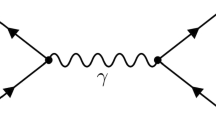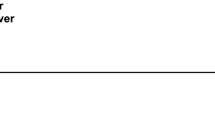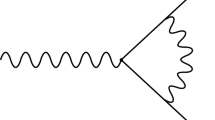Summary
Unitarity, crossing and analyticity (in the domain resulting from axiomatic field theory) are combined to derive upper bounds on the pion-pion scattering amplitudeinside its analyticity domain and sum rules over thephysical pion-pion amplitude, in particular over total cross-sections. The bounds are obtained in completely rigorous way and contain no free parameters except the mass of the pion. The assumptions are: 1) the lightest strongly interacting particles are three pseudoscalar particles π+π−π0 with equal masses and such that π0 is self-conjugate, π+π− are mutual conjugate. It is not necessary to assume, that they belong to an isospin triplet. ii) The ππ system has no bound state. iii) The assumptions of AFT—with unitarity included—hold.
Riassunto
Unitarietà, incrocio ed analiticità (nel dominio risultante da una teoria di campo assiomatica) sono combinati per derivare i limiti superiori dell’ampiezza d’urto pionepione, all’interno del suo dominio analitico, e regole di somma sull’ampiezza fisica pione-pione, in particolare sulle sezioni d’urto totali. I limiti sono ottenuti in modo assolutamente rigoroso e non contengono parametri liberi tranne la massa del pione. Le ipotesi sono: i) Le particelle più leggere interagenti fortemente sono tre particelle pseudoscalari π+π−π0 di ugual massa e tali che π0 è autoconiugata, π+π− sono mutuamente coniugate. Non è necessario fare l’ipotesi che esse appartengano ad un tripletto di isospin. ii) Il sistema πп non ha uno stato legato. iii) Sono valide le ipotesi di AFT, unitarietà inclusa.
Резюме
Унитарность, кроссинг и ананлитичность (в области, полученной из аксиоматической теорин поля) объединяются для вывода верхних границ на амплитуду пион-пионного рассеяниявнумру области аналитичности и правил сумм по физической пион-пионной амплитуде, в частности, по полным поперечным сечениям. Границы получаются строгим образом и не содержат свободных параметров, за исключением массы пиона. Предположениями являются: 1) Легчайшими сильно-взаимодействующими частицами являются псевдоскалярные частицы π+π−π0 с равными массами, и такие, что π0 является самосопряженной частицей π+π− являются взаимно-сопряженными. Но не является необходимым предположение, что они принадлежат к изотопическому триплету. 2) Система πп не имеет связанного состояния. 3) Выполняются предположения АТП (AFT)—с учетом унитарности.
Similar content being viewed by others
References
M. Froissart:Phys. Rev.,123, 1053 (1961).
A. Martin:Nuovo Cimento,42, 930 (1966).
Y. Jin andA. Martin:Phys. Rev.,135, B 1375 (1964).
Seee.g. G. Chew andS. Mandelstam:Phys. Rev.,119, 978 (1960).
SeeA. Martin: inProceedings of Trieste Conference (1965). A detailed proof has been given byS. Aks:Journ. Math. Phys.,6, 516 (1965).
A. Martin: Stanford University preprint (August 1964), see also ref. (5).
G. Wanders:Phys. Lett.,19, 331 (1965).
See ref. (2).
L. Łukaszuk:Nuovo Cimento,51 A, 67 (1966).
SeeE. C. Titchmarsh:The Theory of Functions (Oxford, 1939), p. 167.
Author information
Authors and Affiliations
Additional information
Traduzione a cura della Redazione.
Переведено редакцией.
Rights and permissions
About this article
Cite this article
Łukaszuk, L., Martin, A. Absolute upper bounds for ππ scattering. Nuovo Cimento A (1965-1970) 52, 122–145 (1967). https://doi.org/10.1007/BF02739279
Received:
Published:
Issue Date:
DOI: https://doi.org/10.1007/BF02739279




